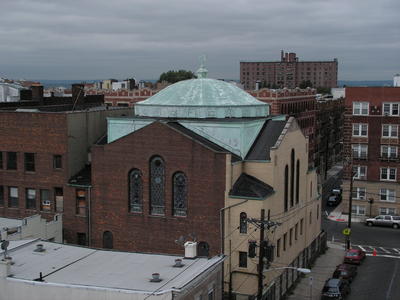On the corner of Palisade Avenue and 54th Street, there is a building with iron gates that may seem to be always closed. Passersby walk past it without thinking much about what goes on inside. But if one were to go back in time a hundred years, the scene would be very different.
The building described is the Shaare Zedek Synagogue, an Orthodox Jewish synagogue in West New York where half a century ago, the Jewish community in the area was much more prevalent than it is today.
However, there are occasions where one may get a glimpse of what it may have been like back then.
Rosh means ‘head’ in Hebrew. Rosh Hashanah means ‘head of the year.’
________
This past Friday was the commencement of the Jewish New Year Holiday of Rosh Hashanah. It ends today, Sunday, at sundown. Next week, Monday, Sept. 28, will be the Jewish holiday of atonement, Yom Kippur. Together, Rosh Hashanah and Yom Kippur are known as the Jewish high holidays.
“On the high holidays, a lot of people come to the synagogue. The big sanctuary is opened; it is very beautiful. It is almost 100 years old,” said Baruch.
This year, Rabbi Baruch, Rabbi Chaim Cohen, and Rabbi David Movsas will be expecting approximately 200 people to come to Shaare Zedek for the high holidays.
Rosh Hashanah
In case you’re wondering, this will mark the year 5770 in the Jewish calendar.
The story behind the Rosh Hashanah, as told by Baruch, is that the holiday marks the day when G-d created Adam, the first man in the world. Rabbi Baruch said that on this day, Jews remember the reason behind the creation of man.
“This is the day when people focus on ‘What is the meaning of my life, why am I here in this world,’ ” said Baruch.
Interestingly, even the name of the holiday has a certain meaning to the occasion.
“’Rosh’ means ‘head’ [in Hebrew] and ‘shanah’ means ‘year.’ So Rosh Hashanah means the ‘head of the year,’ ” said Baruch. “Why we call it this is because just like a person, the head is the most important part, and when the head is healthy, they have a chance to take care of the rest of the body. In the same way, Rosh Hashanah is the day that G-d gives us all the blessings for the rest of the year.”
Apples with honey are typically eaten during the holiday. Followers say “Good year” in Hebrew: “Shanah Tova.”
Yom Kippur
Yom Kippur is the Day of Atonement in the Jewish religion. It is the day when Jews ask for forgiveness from G-d and from others whom they may have wronged and prepare for judgment from G-d. It is the day when even the least observant Jew takes the day off to go to the synagogue, which is usually full of people.
No work is performed, a 24-hour fast is made, and in orthodox communities, certain things like turning on lights or driving a car are avoided.
“Yom Kippur is the day that G-d forgives us for all our sins,” said Baruch.
Next Monday, the gates and the main doors, which are usually closed, will be opened to welcome to extra amount of people expected to come for observation.
“Everyone should know that they are always welcome to the synagogue,” said Baruch “It is always a pleasure to see every person. It doesn’t matter what is their level of observation.”
Melissa Rappaport may be reached at mrappaport@hudsonreporter.com
